Increased Attention to Smart Development in Rural Areas: A Scientometric Analysis of Smart Village Research
Abstract
1. Introduction
- Review current understandings and implementations related to smart village initiatives and outline a classification system for smart village research topics;
- Describe the historical and geographic distributions of publications related to smart village research;
- Identify the influential contributors and collaboration patterns between differently sized communities;
- Visualize the knowledge base of this field and depict conceptual and intellectual structures;
- Reveal the research evolution trend to identify research hotspots and frontiers;
- Propose a conceptual model capable of displaying an overview of the structure of a smart village ecosystem.
2. Methodology
2.1. Study Design
2.2. Data Collection and Preprocessing
2.3. Techniques and Tools
3. Results
3.1. Preliminary Study
3.1.1. Current Understandings and Implementations
3.1.2. Dimensions of a Smart Village
3.2. Scientometric Analysis
3.2.1. Publication Distributions
Annual Distribution
- Incubation phase (1998–2014).In the exploration phase, there were 41 relevant documents. Since we adopted a broad search with multiple related terms, most studies in this phase discussed smart rural areas under the framework of smart growth, smart community, and smart city discourse. The earliest document available in Scopus dates back to 1998 and is titled “Communities left behind: Can nonviable places become smart?” [94]. In this paper, the author noticed the recent attention to “growth from within” strategies, emphasized rural endogenous development, and suggested quantitative measures for more pragmatic decision-making. It is noteworthy that the author provided some clues for how nonviable communities could become “smart”, as “smart communities have empowered individuals, skilled leadership, innovative institutions, cultural capital, and social capital”. Although there have been practical implementations, such as Climate-Smart Villages (2011), the Smart Village Initiative (2014), and the IEEE Smart Village (2014), as stated earlier, their influence seems to show a period of lag in the academic literature.
- Initial development (2015–present).During this phase, the distribution of annual publications witnessed a period of rapid growth. There are 384 relevant documents, including data from 2021. We defined this phase as the initial development phase because the volume of annual publications related to smart villages is small compared with smart city research. In 2015, the SDGs of the UN General Assembly, known as the 2030 Agenda, were issued, which might have been an important motivation for the significant increase in academic concern towards rural smart development. Among the retrieved journal articles and conference papers, Azizul et al. [81] first mentioned the “smart village” concept as a rural development initiative in a conference paper aiming to support the Smart City Smart Village (SCSV) project within the Digital Malaysia initiative through computing technology. Like Malaysia, during this period, many global, regional, and national agendas adopted the smart village concept and applied it in policy-making and implementations, as concluded in the previous section (Table 2). The dramatic surge in publications shows how public policy agendas, pragmatic practices, and scientific activities influence each other.
Geographic Distribution
3.2.2. Relevant Contributors and Collaboration Patterns
Authors
Sources
Co-Author Relationships
3.2.3. Hotspots, Structures, and Trends
Most Frequent Keywords
Keyword Co-Occurrence Analysis: Conceptual Structure
Co-Citation Analysis: Intellectual Structure
Thematic Evolution
- Smart village research was initially derived from themes related to smart cities, smart communities, regional planning, and sustainable development. These themes were mainly basic themes, motor themes, and niche themes in subperiod A;
- Sustainable development remained a significant idea throughout the thematic evolution. It was developed in 2015 and has since matured into a basic theme;
- Technology-dimension-related themes (e.g., AI, communication technology, and the IoT) continuously evolve, transfer with a high degree of flexibility, and remain motor themes. These themes commonly merge with themes related to other dimensions (e.g., resources, governance, and the economy) and generate new themes (e.g., smart power grids, e-governance, and smart agriculture), implying a wide range of applications for these technologies;
- Regarding subperiod D, motor themes that are well developed and have potential can be identified as subtopics in the economic dimension, such as climate-smart agriculture and rural tourism, as well as emerging technologies such as AI, the IoT, and robotics. Quality of life (i.e., smart living) and community-centered studies might become promising emerging themes in the future.
3.3. Proposed Conceptual Model
4. Discussion
4.1. Rural Smart Development Needs Tailored Solutions
4.2. Technology Serves as a Means Rather than an End
4.3. People Are at the Core of the Smart Village Ecosystem
5. Conclusions
Author Contributions
Funding
Institutional Review Board Statement
Informed Consent Statement
Data Availability Statement
Acknowledgments
Conflicts of Interest
Appendix A
| Query 1 | Query 2 | Query 3 | Query 4 | Query 5 | |
|---|---|---|---|---|---|
| Query string | TITLE-ABS-KEY (“*smart* village*”) | TITLE-ABS-KEY (“*smart rural*” OR “*smart countryside*”) | TITLE-ABS-KEY (“*smart cit*”) AND KEY (rural* OR village* OR countryside*) | TITLE-ABS-KEY (“smart growth*” OR “smart develop*”) AND TITLE-ABS-KEY (rural* OR village* OR countryside*) | TITLE-ABS-KEY (“smart communit*” OR “smart territor*” OR “smart region*” OR “*smart settlement*”) AND TITLE-ABS-KEY (rural* OR village* OR countryside*) |
| Limit to | Document Type | Article (ar) or Review (re) or Conference Paper (cp) | LIMIT-TO (DOCTYPE, “ar”) OR LIMIT-TO (DOCTYPE, “cp”) OR LIMIT-TO (DOCTYPE,”re”) | ||
| Language | English | LIMIT-TO (LANGUAGE, “English”) | |||
| Search results | 209 | 75 | 181 | 96 | 58 |
| After screening | 207 | 75 | 121 | 61 | 56 |
| Retrieval period | 16 October 2021 to 6 November | ||||
| Removed duplicates | 95 | ||||
| Final records | 425 (Articles, 201; Conference papers, 208; Reviews, 16) | ||||
Appendix B
| Author Keywords | Indexed Keywords | ||||
|---|---|---|---|---|---|
| Dimensions (Freq.) | Keywords (Freq.) | Dimensions (Freq.) | Keywords (Freq.) | ||
| Others | Challenges (9) | climate change (6) depopulation (3) | Others | Challenges (13) | climate change (13) |
| Objectives (83) | rural development (17) sustainable development (13) smart growth (12) sustainability (12) smart development (7) regional development (5) resilience (4) village development (4) adaptation (3) climate change adaptation (3) community development (3) | Objectives (128) | sustainable development (53) rural development (39) sustainability (15) urban growth (12) regional development (9) | ||
| Conditions (38) | rural area (21) rural (8) urbanization (5) India (4) | Conditions (296) | rural area (201) village (29) United States (18) developing countries (14) European union (12) urban and rural area (11) urban area (11) | ||
| Governance (27) | digitalization (9) e-governance (6) policy (4) smart specialization (4) spatial planning (4) | Governance (110) | regional planning (30) decision-making (19) planning (17) urban planning (17) surveys (11) e-governance (8) information management (8) | ||
| Technology (97) | IoT (35) ICT (16) big data (7) artificial intelligence (6) GIS (6) AHP (5) lpwan (5) sensors (5) cloud (3) cloud computing (3) clustering (3) digital technology (3) | Technology (118) | IoT (50) big data (25) artificial intelligence (15) ICT (15) agricultural robots (13) | ||
| Economy (16) | climate-smart agriculture (9) agriculture (4) e-commerce (3) | Economy (81) | agriculture (21) investment (18) commerce (14) economics (10) tourism (10) costs (8) | ||
| Infrastructure (13) | smart grid (7) micro grid (6) | Infrastructure (68) | electric power transmission network (23) smart power grid (23) smart grid (12) micro grid (10) | ||
| Resource (18) | renewable energy (7) energy efficiency (4) solar energy (4) energy (3) | Resource (66) | energy efficiency (17) renewable energy resources (13) solar energy (10) renewable energies (9) water quality (9) ecosystem (8) | ||
| Society (7) | smart community (7) | Society (44) | information system (13) smart community (12) rural community (10) digital storage (9) | ||
| Services (7) | mobility (4) connectivity (3) | Service (34) | information use (13) energy utilization (11) water supply (10) | ||
References
- The United Nations. #Envision2030: 17 Goals to Transform the World for Persons with Disabilities|United Nations Enable. Available online: https://www.un.org/development/desa/disabilities/envision2030.html (accessed on 28 July 2022).
- Anderson, A.; Loomba, P.; Orajaka, I.; Numfor, J.; Saha, S.; Janko, S.; Johnson, N.; Podmore, R.; Larsen, R. Empowering Smart Communities: Electrification, Education, and Sustainable Entrepreneurship in IEEE Smart Village Initiatives. IEEE Electrific. Mag. 2017, 5, 6–16. [Google Scholar] [CrossRef]
- Min, K.; Yoon, M.; Furuya, K. A Comparison of a Smart City’s Trends in Urban Planning before and after 2016 through Keyword Network Analysis. Sustainability 2019, 11, 3155. [Google Scholar] [CrossRef]
- Adamowicz, M.; Zwolińska-Ligaj, M. The “Smart Village” as a Way to Achieve Sustainable Development in Rural Areas of Poland. Sustainability 2020, 12, 6503. [Google Scholar] [CrossRef]
- Edwards, M.M.; Haines, A. Evaluating Smart Growth: Implications for Small Communities. J. Plan. Educ. Res. 2007, 27, 49–64. [Google Scholar] [CrossRef]
- Sutriadi, R. Defining Smart City, Smart Region, Smart Village, and Technopolis as an Innovative Concept in Indonesia’s Urban and Regional Development Themes to Reach Sustainability. IOP Conf. Ser. Earth Environ. Sci. 2018, 202, 012047. [Google Scholar] [CrossRef]
- Zavratnik, V.; Kos, A.; Stojmenova Duh, E. Smart Villages: Comprehensive Review of Initiatives and Practices. Sustainability 2018, 10, 2559. [Google Scholar] [CrossRef]
- Ye, L.; Mandpe, S.; Meyer, P.B. What Is “Smart Growth?”—Really? J. Plan. Lit. 2005, 19, 301–315. [Google Scholar] [CrossRef]
- Dameri, R.P. Searching for Smart City Definition: A Comprehensive Proposal. IJCT 2013, 11, 2544–2551. [Google Scholar] [CrossRef]
- Eremia, M.; Toma, L.; Sanduleac, M. The Smart City Concept in the 21st Century. Procedia Eng. 2017, 181, 12–19. [Google Scholar] [CrossRef]
- Vanolo, A. Smartmentality: The Smart City as Disciplinary Strategy. Urban Stud. 2014, 51, 883–898. [Google Scholar] [CrossRef]
- Zubizarreta, I.; Seravalli, A.; Arrizabalaga, S. Smart City Concept: What It Is and What It Should Be. J. Urban Plann. Dev. 2016, 142, 04015005. [Google Scholar] [CrossRef]
- Rosati, U.; Conti, S. What Is a Smart City Project? An Urban Model or A Corporate Business Plan? Procedia—Soc. Behav. Sci. 2016, 223, 968–973. [Google Scholar] [CrossRef][Green Version]
- Kitchin, R.; Cardullo, P.; Di Feliciantonio, C. Citizenship, Justice, and the Right to the Smart City. In The Right to the Smart City; Cardullo, P., Di Feliciantonio, C., Kitchin, R., Eds.; Emerald Publishing Limited: Bingley, UK, 2019; pp. 1–24. ISBN 9781787691407. [Google Scholar]
- Spicer, Z.; Goodman, N.; Olmstead, N. The Frontier of Digital Opportunity: Smart City Implementation in Small, Rural and Remote Communities in Canada. Urban Stud. 2021, 58, 535–558. [Google Scholar] [CrossRef]
- Cunha, C.R.; Gomes, J.P.; Fernandes, J.; Morais, E.P. Building Smart Rural Regions: Challenges and Opportunities. In Trends and Innovations in Information Systems and Technologies; Rocha, Á., Adeli, H., Reis, L.P., Costanzo, S., Orovic, I., Moreira, F., Eds.; Advances in Intelligent Systems and Computing; Springer International Publishing: Cham, Switzerland, 2020; Volume 1161, pp. 579–589. ISBN 9783030456962. [Google Scholar]
- Anastasiou, E.; Manika, S.; Ragazou, K.; Katsios, I. Territorial and Human Geography Challenges: How Can Smart Villages Support Rural Development and Population Inclusion? Soc. Sci. 2021, 10, 193. [Google Scholar] [CrossRef]
- Rodríguez-Soler, R.; Uribe-Toril, J.; De Pablo Valenciano, J. Worldwide Trends in the Scientific Production on Rural Depopulation, a Bibliometric Analysis Using Bibliometrix R-Tool. Land Use Policy 2020, 97, 104787. [Google Scholar] [CrossRef]
- Philip, L.; Cottrill, C.; Farrington, J.; Williams, F.; Ashmore, F. The Digital Divide: Patterns, Policy and Scenarios for Connecting the ‘Final Few’ in Rural Communities across Great Britain. J. Rural Stud. 2017, 54, 386–398. [Google Scholar] [CrossRef]
- Chakrabarty, A. Smart Mischief: An Attempt to Demystify the Smart Cities Craze in India. Environ. Urban. 2019, 31, 193–208. [Google Scholar] [CrossRef]
- Cowie, P.; Townsend, L.; Salemink, K. Smart Rural Futures: Will Rural Areas Be Left behind in the 4th Industrial Revolution? J. Rural Stud. 2020, 79, 169–176. [Google Scholar] [CrossRef]
- Kaur, P.; Parashar, A. A Systematic Literature Review of Blockchain Technology for Smart Villages. Arch. Comput. Methods Eng. 2022, 29, 2417–2468. [Google Scholar] [CrossRef]
- Malik, P.K.; Singh, R.; Gehlot, A.; Akram, S.V.; Kumar Das, P. Village 4.0: Digitalization of Village with Smart Internet of Things Technologies. Comput. Ind. Eng. 2022, 165, 107938. [Google Scholar] [CrossRef]
- Mohammed, A.J. Don’t Let the Digital Divide Become ‘the New Face of Inequality’: UN Deputy Chief. Available online: https://news.un.org/en/story/2021/04/1090712 (accessed on 28 July 2022).
- Visvizi, A.; Lytras, M.D. Rescaling and Refocusing Smart Cities Research: From Mega Cities to Smart Villages. JSTPM 2018, 9, 134–145. [Google Scholar] [CrossRef]
- Komorowski, Ł.; Stanny, M. Smart Villages: Where Can They Happen? Land 2020, 9, 151. [Google Scholar] [CrossRef]
- Naldi, L.; Nilsson, P.; Westlund, H.; Wixe, S. What Is Smart Rural Development? J. Rural Stud. 2015, 40, 90–101. [Google Scholar] [CrossRef]
- Visvizi, A.; Lytras, M. It’s Not a Fad: Smart Cities and Smart Villages Research in European and Global Contexts. Sustainability 2018, 10, 2727. [Google Scholar] [CrossRef]
- Hosseini, S.; Frank, L.; Fridgen, G.; Heger, S. Do Not Forget About Smart Towns: How to Bring Customized Digital Innovation to Rural Areas. Bus. Inf. Syst. Eng. 2018, 60, 243–257. [Google Scholar] [CrossRef]
- Park, C.; Cha, J. A Trend on Smart Village and Implementation of Smart Village Platform. Int. J. Adv. Smart Converg. 2019, 8, 177–183. [Google Scholar] [CrossRef]
- Stojanova, S.; Lentini, G.; Niederer, P.; Egger, T.; Cvar, N.; Kos, A.; Stojmenova Duh, E. Smart Villages Policies: Past, Present and Future. Sustainability 2021, 13, 1663. [Google Scholar] [CrossRef]
- Tranfield, D.; Denyer, D.; Smart, P. Towards a Methodology for Developing Evidence-Informed Management Knowledge by Means of Systematic Review. Br. J. Manag. 2003, 14, 207–222. [Google Scholar] [CrossRef]
- Henry, B.M.; Skinningsrud, B.; Vikse, J.; Pękala, P.A.; Walocha, J.A.; Loukas, M.; Tubbs, R.S.; Tomaszewski, K.A. Systematic Reviews versus Narrative Reviews in Clinical Anatomy: Methodological Approaches in the Era of Evidence-based Anatomy. Clin. Anat. 2018, 31, 364–367. [Google Scholar] [CrossRef]
- Hammersley, M. On “Systematic” Reviews of Research Literatures: A “Narrative” Response to Evans & Benefield. Br. Educ. Res. J. 2001, 27, 543–554. [Google Scholar] [CrossRef]
- Munn, Z.; Peters, M.D.J.; Stern, C.; Tufanaru, C.; McArthur, A.; Aromataris, E. Systematic Review or Scoping Review? Guidance for Authors When Choosing between a Systematic or Scoping Review Approach. BMC Med. Res. Methodol. 2018, 18, 143. [Google Scholar] [CrossRef] [PubMed]
- Mishbah, M.; Purwandari, B.; Sensuse, D.I. Systematic Review and Meta-Analysis of Proposed Smart Village Conceptual Model: Objectives, Strategies, Dimensions, and Foundations. In Proceedings of the 2018 International Conference on Information Technology Systems and Innovation (ICITSI), Bandung, Indonesia, 22–26 October 2018; pp. 127–133. [Google Scholar]
- Mukti, I.Y.; Iacob, M.E.; Aldea, A.; Govindaraju, R.; van Hillegersberg, J. Defining Rural Smartness and Its Impact: A Systematic Literature Review. J. Knowl. Econ. 2022, 13, 956–1007. [Google Scholar] [CrossRef]
- Gerli, P.; Marco, J.N.; Whalley, J. What Makes a Smart Village Smart? A Review of the Literature. Transform. Gov. People Process Policy 2022, 16, 292–304. [Google Scholar] [CrossRef]
- Ferreira, M.P.; Santos, J.C.; de Almeida, M.I.R.; Reis, N.R. Mergers & Acquisitions Research: A Bibliometric Study of Top Strategy and International Business Journals, 1980–2010. J. Bus. Res. 2014, 67, 2550–2558. [Google Scholar] [CrossRef]
- Ellegaard, O.; Wallin, J.A. The Bibliometric Analysis of Scholarly Production: How Great Is the Impact? Scientometrics 2015, 105, 1809–1831. [Google Scholar] [CrossRef]
- Biggi, G.; Giuliani, E. The Noxious Consequences of Innovation: What Do We Know? Ind. Innov. 2021, 28, 19–41. [Google Scholar] [CrossRef]
- Börner, K.; Chen, C.; Boyack, K.W. Visualizing Knowledge Domains. Ann. Rev. Inf. Sci. Tech. 2005, 37, 179–255. [Google Scholar] [CrossRef]
- Ivancheva, L. Scientometrics Today: A Methodological Overview. Collnet J. Scientometr. Inf. Manag. 2008, 2, 47–56. [Google Scholar] [CrossRef]
- Mingers, J.; Leydesdorff, L. A Review of Theory and Practice in Scientometrics. Eur. J. Oper. Res. 2015, 246, 1–19. [Google Scholar] [CrossRef]
- Chen, C.; Song, M. Representing Scientific Knowledge: The Role of Uncertainty; Springer International Publishing: Cham, Switzerland, 2017; ISBN 9783319625416. [Google Scholar]
- Schoepflin, U.; Glanzel, W. Two Decades of “Scientometrics”. An Interdisciplinary Field Represented by Its Leading Journal. Scientometrics 2001, 50, 301–312. [Google Scholar] [CrossRef]
- Zupic, I.; Čater, T. Bibliometric Methods in Management and Organization. Organ. Res. Methods 2015, 18, 429–472. [Google Scholar] [CrossRef]
- Aria, M.; Cuccurullo, C. Bibliometrix: An R-Tool for Comprehensive Science Mapping Analysis. J. Informetr. 2017, 11, 959–975. [Google Scholar] [CrossRef]
- Elsevier. Why Choose Scopus—Scopus Benefits|Elsevier Solutions. Available online: https://www.elsevier.com/solutions/scopus/why-choose-scopus (accessed on 28 July 2022).
- Norris, M.; Oppenheim, C. Comparing Alternatives to the Web of Science for Coverage of the Social Sciences’ Literature. J. Informetr. 2007, 1, 161–169. [Google Scholar] [CrossRef]
- Mongeon, P.; Paul-Hus, A. The Journal Coverage of Web of Science and Scopus: A Comparative Analysis. Scientometrics 2016, 106, 213–228. [Google Scholar] [CrossRef]
- Adriaanse, S.L.; Rensleigh, C. Web of Science, Scopus and Google Scholar: A Content Comprehensiveness Comparison. Electron. Libr. 2013, 31, 727–744. [Google Scholar] [CrossRef]
- Grazieschi, G.; Asdrubali, F.; Guattari, C. Neighbourhood Sustainability: State of the Art, Critical Review and Space-Temporal Analysis. Sustain. Cities Soc. 2020, 63, 102477. [Google Scholar] [CrossRef]
- Malanski, P.D.; Dedieu, B.; Schiavi, S. Mapping the Research Domains on Work in Agriculture. A Bibliometric Review from Scopus Database. J. Rural Stud. 2021, 81, 305–314. [Google Scholar] [CrossRef]
- Wu, Z.; Jiang, M.; Li, H.; Zhang, X. Mapping the Knowledge Domain of Smart City Development to Urban Sustainability: A Scientometric Study. J. Urban Technol. 2021, 28, 29–53. [Google Scholar] [CrossRef]
- Franceschini, F.; Maisano, D.; Mastrogiacomo, L. Empirical Analysis and Classification of Database Errors in Scopus and Web of Science. J. Informetr. 2016, 10, 933–953. [Google Scholar] [CrossRef]
- Noyons, E.C.M.; Moed, H.F.; Van Raan, A.F.J. Integrating Research Performance Analysis and Science Mapping. Scientometrics 1999, 46, 591–604. [Google Scholar] [CrossRef]
- Cobo, M.J.; López-Herrera, A.G.; Herrera-Viedma, E.; Herrera, F. An Approach for Detecting, Quantifying, and Visualizing the Evolution of a Research Field: A Practical Application to the Fuzzy Sets Theory Field. J. Informetr. 2011, 5, 146–166. [Google Scholar] [CrossRef]
- Kastrin, A.; Hristovski, D. Scientometric Analysis and Knowledge Mapping of Literature-Based Discovery (1986–2020). Scientometrics 2021, 126, 1415–1451. [Google Scholar] [CrossRef]
- Hirsch, J.E. An Index to Quantify an Individual’s Scientific Research Output. Proc. Natl. Acad. Sci. USA 2005, 102, 16569–16572. [Google Scholar] [CrossRef] [PubMed]
- Chen, C. Science Mapping: A Systematic Review of the Literature. J. Data Inf. Sci. 2017, 2, 1–40. [Google Scholar] [CrossRef]
- Small, H. Co-Citation in the Scientific Literature: A New Measure of the Relationship between Two Documents. J. Am. Soc. Inf. Sci. 1973, 24, 265–269. [Google Scholar] [CrossRef]
- Callon, M.; Courtial, J.-P.; Turner, W.A.; Bauin, S. From Translations to Problematic Networks: An Introduction to Co-Word Analysis. Soc. Sci. Inf. 1983, 22, 191–235. [Google Scholar] [CrossRef]
- Newman, M.E.J. The Structure of Scientific Collaboration Networks. Proc. Natl. Acad. Sci. USA 2001, 98, 404–409. [Google Scholar] [CrossRef]
- Donthu, N.; Kumar, S.; Mukherjee, D.; Pandey, N.; Lim, W.M. How to Conduct a Bibliometric Analysis: An Overview and Guidelines. J. Bus. Res. 2021, 133, 285–296. [Google Scholar] [CrossRef]
- Cobo, M.J.; López-Herrera, A.G.; Herrera-Viedma, E.; Herrera, F. Science Mapping Software Tools: Review, Analysis, and Cooperative Study among Tools. J. Am. Soc. Inf. Sci. 2011, 62, 1382–1402. [Google Scholar] [CrossRef]
- Van Eck, N.J.; Waltman, L. Software Survey: VOSviewer, a Computer Program for Bibliometric Mapping. Scientometrics 2010, 84, 523–538. [Google Scholar] [CrossRef]
- Daniels, T. Smart Growth: A New American Approach to Regional Planning. Plan. Pract. Res. 2001, 16, 271–279. [Google Scholar] [CrossRef]
- O’Connell, L. Exploring the Social Roots of Smart Growth Policy Adoption by Cities *. Soc. Sci. Q. 2008, 89, 1356–1372. [Google Scholar] [CrossRef]
- Tregoning, H.; Agyeman, J.; Shenot, C. Sprawl, Smart Growth and Sustainability. Local Environ. 2002, 7, 341–347. [Google Scholar] [CrossRef]
- Ingwersen, P.; Serrano-López, A.E. Smart City Research 1990–2016. Scientometrics 2018, 117, 1205–1236. [Google Scholar] [CrossRef]
- Houghton, J.W. ICT and the Environment in Developing Countries: A Review of Opportunities and Developments. In What Kind of Information Society? Governance, Virtuality, Surveillance, Sustainability, Resilience; Berleur, J., Hercheui, M.D., Hilty, L.M., Eds.; IFIP Advances in Information and Communication Technology; Springer: Berlin/Heidelberg, Germany, 2010; Volume 328, pp. 236–247. ISBN 9783642154782. [Google Scholar]
- Erixon, F. The Europe 2020 Strategy: Time for Europe to Think Again. Eur. View 2010, 9, 29–37. [Google Scholar] [CrossRef]
- Ella, S.; Andari, R.N. Developing a Smart Village Model for Village Development in Indonesia. In Proceedings of the 2018 International Conference on ICT for Smart Society (ICISS), Semarang, Indonesia, 10–11 October 2018; pp. 1–6. [Google Scholar]
- Aziiza, A.A.; Susanto, T.D. The Smart Village Model for Rural Area (Case Study: Banyuwangi Regency). IOP Conf. Ser. Mater. Sci. Eng. 2020, 722, 012011. [Google Scholar] [CrossRef]
- Viswanadham, N.; Vedula, S. Design of Smart Villages. Cent. Glob. Logist. Manuf. Strat. 2010, 1–16. [Google Scholar]
- Neirotti, P.; De Marco, A.; Cagliano, A.C.; Mangano, G.; Scorrano, F. Current Trends in Smart City Initiatives: Some Stylised Facts. Cities 2014, 38, 25–36. [Google Scholar] [CrossRef]
- CCAFS. Climate-Smart Villages. Available online: https://ccafs.cgiar.org/climate-smart-villages (accessed on 28 July 2022).
- Smart Villages Research Group Welcome to SVRG|Smart Villages Research Group. Available online: https://e4sv.org/ (accessed on 28 July 2022).
- IEEE Smart Village About IEEE Smart Village—IEEE Smart Village. Available online: https://smartvillage.ieee.org/about-ieee-smart-village/ (accessed on 20 July 2022).
- Azizul, N.H.; Nasruddin, M.F.; Rosmadi, M.; Zin, A.M. Advanced Ubiquitous Computing to Support Smart City Smart Village Applications. In Proceedings of the 2015 International Conference on Electrical Engineering and Informatics (ICEEI), Denpasar, Bali, Indonesia, 10–11 August 2015; pp. 720–725. [Google Scholar]
- SPMRM|Ministry of Rural Development|GOI. Available online: https://rurban.gov.in/index.php/public_home/about_us#gsc.tab=0 (accessed on 28 July 2022).
- Paneva, V. EU Action for Smart Villages. Available online: https://enrd.ec.europa.eu/news-events/news/eu-action-smart-villages_en (accessed on 28 July 2022).
- Xinhuanet. General Office of the CPC Central Committee. General Office of the State Council issued the “Outline of Digital Countryside Development Strategy” _Central Relevant Documents_Chinese Government Website. Available online: http://www.gov.cn/zhengce/2019-05/16/content_5392269.htm (accessed on 28 July 2022).
- Zhang, X.; Zhang, Z. How Do Smart Villages Become a Way to Achieve Sustainable Development in Rural Areas? Smart Village Planning and Practices in China. Sustainability 2020, 12, 10510. [Google Scholar] [CrossRef]
- Giffinger, R.; Gudrun, H. Smart Cities Ranking: An Effective Instrument for the Positioning of the Cities? ACE: Archit. City Environ. 2010, 4, 7–26. [Google Scholar] [CrossRef]
- Bibri, S.E.; Krogstie, J. Smart Sustainable Cities of the Future: An Extensive Interdisciplinary Literature Review. Sustain. Cities Soc. 2017, 31, 183–212. [Google Scholar] [CrossRef]
- Philip, L.; Williams, F. Healthy Ageing in Smart Villages? Observations from the Field. Eur. Countrys. 2019, 11, 616–633. [Google Scholar] [CrossRef]
- Shcherbina, E.; Gorbenkova, E. Smart City Technologies for Sustainable Rural Development. IOP Conf. Ser. Mater. Sci. Eng. 2018, 365, 022039. [Google Scholar] [CrossRef]
- Guzal-Dec, D.; Zwolińska-Ligaj, M.; Zbucki, Ł. The Potential of Smart Development of Urban-Rural Communes in Peripheral Region (a Case Study of the Lublin Region, Poland). Misc. Geogr. 2019, 23, 85–91. [Google Scholar] [CrossRef]
- Albino, V.; Berardi, U.; Dangelico, R.M. Smart Cities: Definitions, Dimensions, Performance, and Initiatives. J. Urban Technol. 2015, 22, 3–21. [Google Scholar] [CrossRef]
- Dameri, R.P.; Cocchia, A. Smart City and Digital City: Twenty Years of Terminology Evolution; ITAIS: Trento, Italy, 2013; Volume 1. [Google Scholar]
- Zheng, C.; Yuan, J.; Zhu, L.; Zhang, Y.; Shao, Q. From Digital to Sustainable: A Scientometric Review of Smart City Literature between 1990 and 2019. J. Clean. Prod. 2020, 258, 120689. [Google Scholar] [CrossRef]
- Barkley, D.L. Communities Left behind: Can Nonviable Places Become Smart? Rev. Reg. Stud. 1998, 28, 1–17. [Google Scholar] [CrossRef]
- Newman, M.E.J. Coauthorship Networks and Patterns of Scientific Collaboration. Proc. Natl. Acad. Sci. USA 2004, 101, 5200–5205. [Google Scholar] [CrossRef]
- Liu, X.; Bollen, J.; Nelson, M.L.; Van de Sompel, H. Co-Authorship Networks in the Digital Library Research Community. Inf. Processing Manag. 2005, 41, 1462–1480. [Google Scholar] [CrossRef]
- Uddin, S.; Hossain, L.; Abbasi, A.; Rasmussen, K. Trend and Efficiency Analysis of Co-Authorship Network. Scientometrics 2012, 90, 687–699. [Google Scholar] [CrossRef]
- Tripathi, M.; Kumar, S.; Sonker, S.K.; Babbar, P. Occurrence of Author Keywords and Keywords plus in Social Sciences and Humanities Research: A Preliminary Study. COLLNET J. Scientometr. Inf. Manag. 2018, 12, 215–232. [Google Scholar] [CrossRef]
- Elsevier. How Do Author Keywords and Indexed Keywords Work? Scopus: Access and Use Support Center. Available online: https://service.elsevier.com/app/answers/detail/a_id/21730/supporthub/scopus/ (accessed on 29 July 2022).
- Shi, J.; Duan, K.; Wu, G.; Zhang, R.; Feng, X. Comprehensive Metrological and Content Analysis of the Public–Private Partnerships (PPPs) Research Field: A New Bibliometric Journey. Scientometrics 2020, 124, 2145–2184. [Google Scholar] [CrossRef]
- Caragliu, A.; Del Bo, C.; Nijkamp, P. Smart Cities in Europe. J. Urban Technol. 2011, 18, 65–82. [Google Scholar] [CrossRef]
- Nam, T.; Pardo, T.A. Conceptualizing Smart City with Dimensions of Technology, People, and Institutions. In Proceedings of the 12th Annual International Digital Government Research Conference on Digital Government Innovation in Challenging Times—dg.o ’11, College Park, MD, USA, 12–15 June 2011; ACM Press: New York, NY, USA, 2011; p. 282. [Google Scholar]
- Angelidou, M. Smart City Policies: A Spatial Approach. Cities 2014, 41, S3–S11. [Google Scholar] [CrossRef]
- Salemink, K.; Strijker, D.; Bosworth, G. Rural Development in the Digital Age: A Systematic Literature Review on Unequal ICT Availability, Adoption, and Use in Rural Areas. J. Rural Stud. 2017, 54, 360–371. [Google Scholar] [CrossRef]
- Kitchin, R. The Real-Time City? Big Data and Smart Urbanism. GeoJournal 2014, 79, 1–14. [Google Scholar] [CrossRef]
- Callon, M.; Courtial, J.P.; Laville, F. Co-Word Analysis as a Tool for Describing the Network of Interactions between Basic and Technological Research: The Case of Polymer Chemsitry. Scientometrics 1991, 22, 155–205. [Google Scholar] [CrossRef]
- Cahlik, T. Comparison of the Maps of Science. Scientometrics. Scientometrics 2000, 49, 373–387. [Google Scholar] [CrossRef]
- Wang, J.; Lim, M.K.; Wang, C.; Tseng, M.-L. The Evolution of the Internet of Things (IoT) over the Past 20 Years. Comput. Ind. Eng. 2021, 155, 107174. [Google Scholar] [CrossRef]
- Casado-Aranda, L.-A.; Sánchez-Fernández, J.; Bastidas-Manzano, A.-B. Tourism Research after the COVID-19 Outbreak: Insights for More Sustainable, Local and Smart Cities. Sustain. Cities Soc. 2021, 73, 103126. [Google Scholar] [CrossRef]
- Xie, H.; Zhang, Y.; Wu, Z.; Lv, T. A Bibliometric Analysis on Land Degradation: Current Status, Development, and Future Directions. Land 2020, 9, 28. [Google Scholar] [CrossRef]
- Qin, Y.; Xu, Z.; Wang, X.; Škare, M. Green Energy Adoption and Its Determinants: A Bibliometric Analysis. Renew. Sustain. Energy Rev. 2022, 153, 111780. [Google Scholar] [CrossRef]
- Fernandez-Anez, V.; Fernández-Güell, J.M.; Giffinger, R. Smart City Implementation and Discourses: An Integrated Conceptual Model. The Case of Vienna. Cities 2018, 78, 4–16. [Google Scholar] [CrossRef]
- Tödtling, F.; Trippl, M. One Size Fits All? Res. Policy 2005, 34, 1203–1219. [Google Scholar] [CrossRef]
- Camagni, R.; Capello, R. Regional Innovation Patterns and the EU Regional Policy Reform: Toward Smart Innovation Policies: Toward Smart Innovation Policies. Growth Change 2013, 44, 355–389. [Google Scholar] [CrossRef]
- Bielska, A.; Stańczuk-Gałwiaczek, M.; Sobolewska-Mikulska, K.; Mroczkowski, R. Implementation of the Smart Village Concept Based on Selected Spatial Patterns—A Case Study of Mazowieckie Voivodeship in Poland. Land Use Policy 2021, 104, 105366. [Google Scholar] [CrossRef]
- Patnaik, S.; Sen, S.; Mahmoud, M.S. Smart Village Technology: Concepts and Developments. In Modeling and Optimization in Science and Technologies; Springer International Publishing: Cham, Switzerland, 2020; Volume 17, ISBN 9783030377939. [Google Scholar]
- Pérez-delHoyo, R.; Mora, H. Toward a New Sustainable Development Model for Smart Villages. In Smart Villages in the EU and Beyond; Visvizi, A., Lytras, M.D., Mudri, G., Eds.; Emerald Publishing Limited: Bingley, UK, 2019; pp. 49–62. ISBN 9781787698468. [Google Scholar]
- Lytras, M.D.; Visvizi, A.; Mudri, G. Smart Villages: Mapping the Emerging Field and Setting the Course of Action. In Smart Villages in the EU and Beyond; Visvizi, A., Lytras, M.D., Mudri, G., Eds.; Emerald Publishing Limited: Bingley, UK, 2019; pp. 173–176. ISBN 9781787698468. [Google Scholar]
- Macke, J.; Casagrande, R.M.; Sarate, J.A.R.; Silva, K.A. Smart City and Quality of Life: Citizens’ Perception in a Brazilian Case Study. J. Clean. Prod. 2018, 182, 717–726. [Google Scholar] [CrossRef]
- Trencher, G.; Karvonen, A. Stretching “Smart”: Advancing Health and Well-Being through the Smart City Agenda. Local Environ. 2019, 24, 610–627. [Google Scholar] [CrossRef]
- D’Andria, E.; Fiore, P.; Nesticò, A. Small Towns Recovery and Valorisation. An Innovative Protocol to Evaluate the Efficacy of Project Initiatives. Sustainability 2021, 13, 10311. [Google Scholar] [CrossRef]
- Nesticò, A.; Elia, C.; Naddeo, V. Sustainability of Urban Regeneration Projects: Novel Selection Model Based on Analytic Network Process and Zero-One Goal Programming. Land Use Policy 2020, 99, 104831. [Google Scholar] [CrossRef]
- Kummitha, R.K.R.; Crutzen, N. How Do We Understand Smart Cities? An Evolutionary Perspective. Cities 2017, 67, 43–52. [Google Scholar] [CrossRef]
- Colding, J.; Barthel, S. An Urban Ecology Critique on the “Smart City” Model. J. Clean. Prod. 2017, 164, 95–101. [Google Scholar] [CrossRef]
- McFarlane, C.; Söderström, O. On Alternative Smart Cities: From a Technology-Intensive to a Knowledge-Intensive Smart Urbanism. City 2017, 21, 312–328. [Google Scholar] [CrossRef]
- Trencher, G. Towards the Smart City 2.0: Empirical Evidence of Using Smartness as a Tool for Tackling Social Challenges. Technol. Forecast. Soc. Change 2019, 142, 117–128. [Google Scholar] [CrossRef]
- Vaishar, A.; Šťastná, M. Smart Village and Sustainability. Southern Moravia Case Study. Eur. Countrys. 2019, 11, 651–660. [Google Scholar] [CrossRef]
- McGuire, R.; Longo, A.; Sherry, E. Tackling Poverty and Social Isolation Using a Smart Rural Development Initiative. J. Rural Stud. 2022, 89, 161–170. [Google Scholar] [CrossRef]
- Winters, J.V. Why are Smart Cities Growing? Who Moves and who Stays *. J. Reg. Sci. 2011, 51, 253–270. [Google Scholar] [CrossRef]
- Capdevila, I.; Zarlenga, M.I. Smart City or Smart Citizens? The Barcelona Case. J. Strategy Manag. 2015, 8, 266–282. [Google Scholar] [CrossRef]
- Yeh, H. The Effects of Successful ICT-Based Smart City Services: From Citizens’ Perspectives. Gov. Inf. Q. 2017, 34, 556–565. [Google Scholar] [CrossRef]
- Ji, T.; Chen, J.-H.; Wei, H.-H.; Su, Y.-C. Towards People-Centric Smart City Development: Investigating the Citizens’ Preferences and Perceptions about Smart-City Services in Taiwan. Sustain. Cities Soc. 2021, 67, 102691. [Google Scholar] [CrossRef]
- Zavratnik, V.; Podjed, D.; Trilar, J.; Hlebec, N.; Kos, A.; Stojmenova Duh, E. Sustainable and Community-Centred Development of Smart Cities and Villages. Sustainability 2020, 12, 3961. [Google Scholar] [CrossRef]
- Chan, W.-T. Chinese and Western Interpretations of Jen (Humanity). J Chin. Philos. 1975, 2, 107–129. [Google Scholar] [CrossRef]
- Keyt, D. Plato on Justice. In Socratic, Platonic and Aristotelian Studies: Essays in Honor of Gerasimos Santas; Anagnostopoulos, G., Ed.; Springer: Dordrecht, The Netherlands, 2011; pp. 255–270. ISBN 9789400717299. [Google Scholar]
- Lara, A.P.; Moreira Da Costa, E.; Furlani, T.Z.; Yigitcanlar, T. Smartness That Matters: Towards a Comprehensive and Human-Centred Characterisation of Smart Cities. J. Open Innov. 2016, 2, 8. [Google Scholar] [CrossRef]
- Costa, E.M.; Oliveira, Á.D. Humane Smart Cities; Frodeman, R., Ed.; Oxford University Press: Oxford, UK, 2017; Volume 1. [Google Scholar]
- Almeida, V.A.F.; Doneda, D.; Moreira da Costa, E. Humane Smart Cities: The Need for Governance. IEEE Internet Comput. 2018, 22, 91–95. [Google Scholar] [CrossRef]
- Weingart, P. Impact of Bibliometrics upon the Science System: Inadvertent Consequences? Scientometrics 2005, 62, 117–131. [Google Scholar] [CrossRef]
- Wallin, J.A. Bibliometric Methods: Pitfalls and Possibilities. Basic Clin. Pharm. Toxicol. 2005, 97, 261–275. [Google Scholar] [CrossRef]
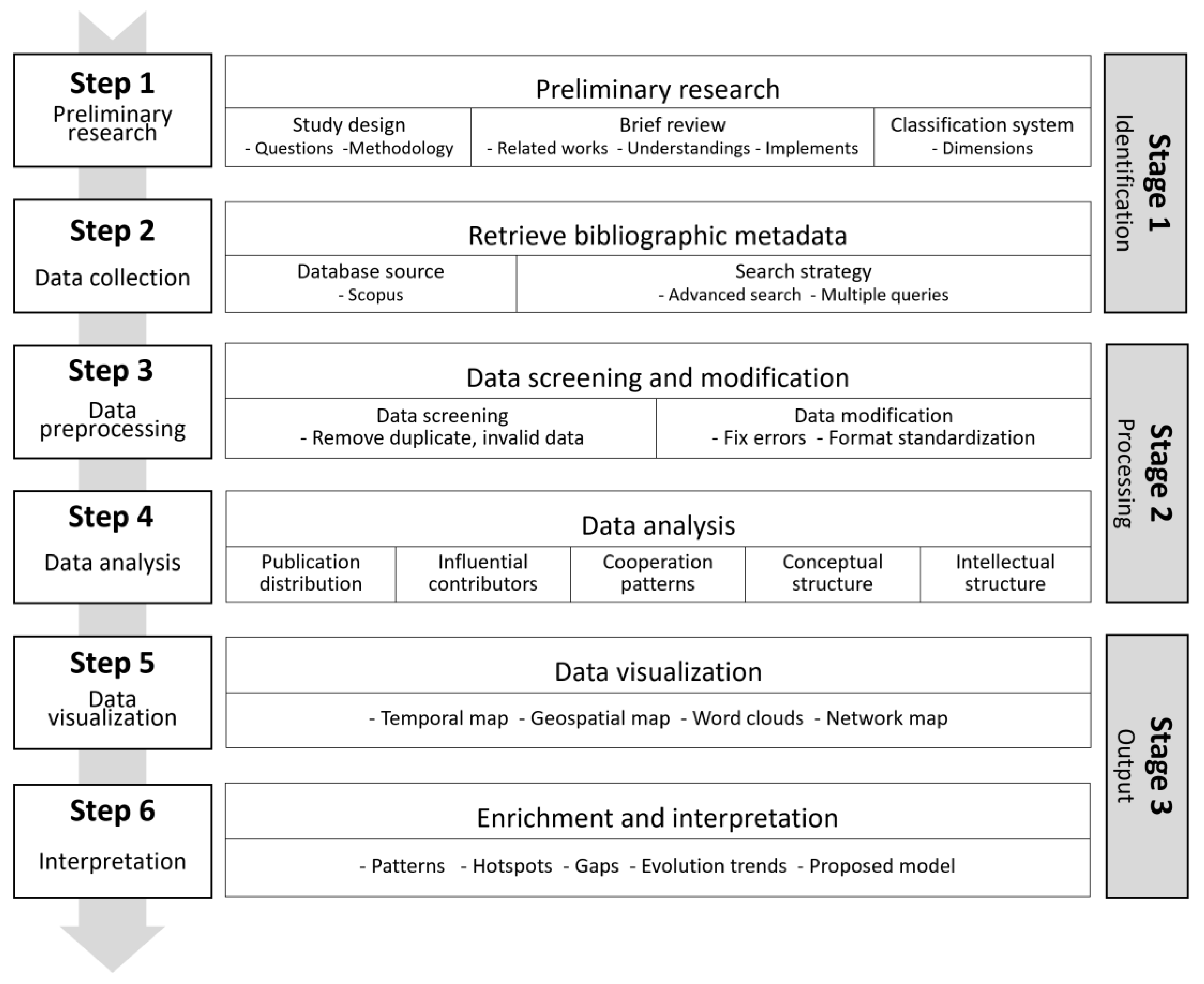

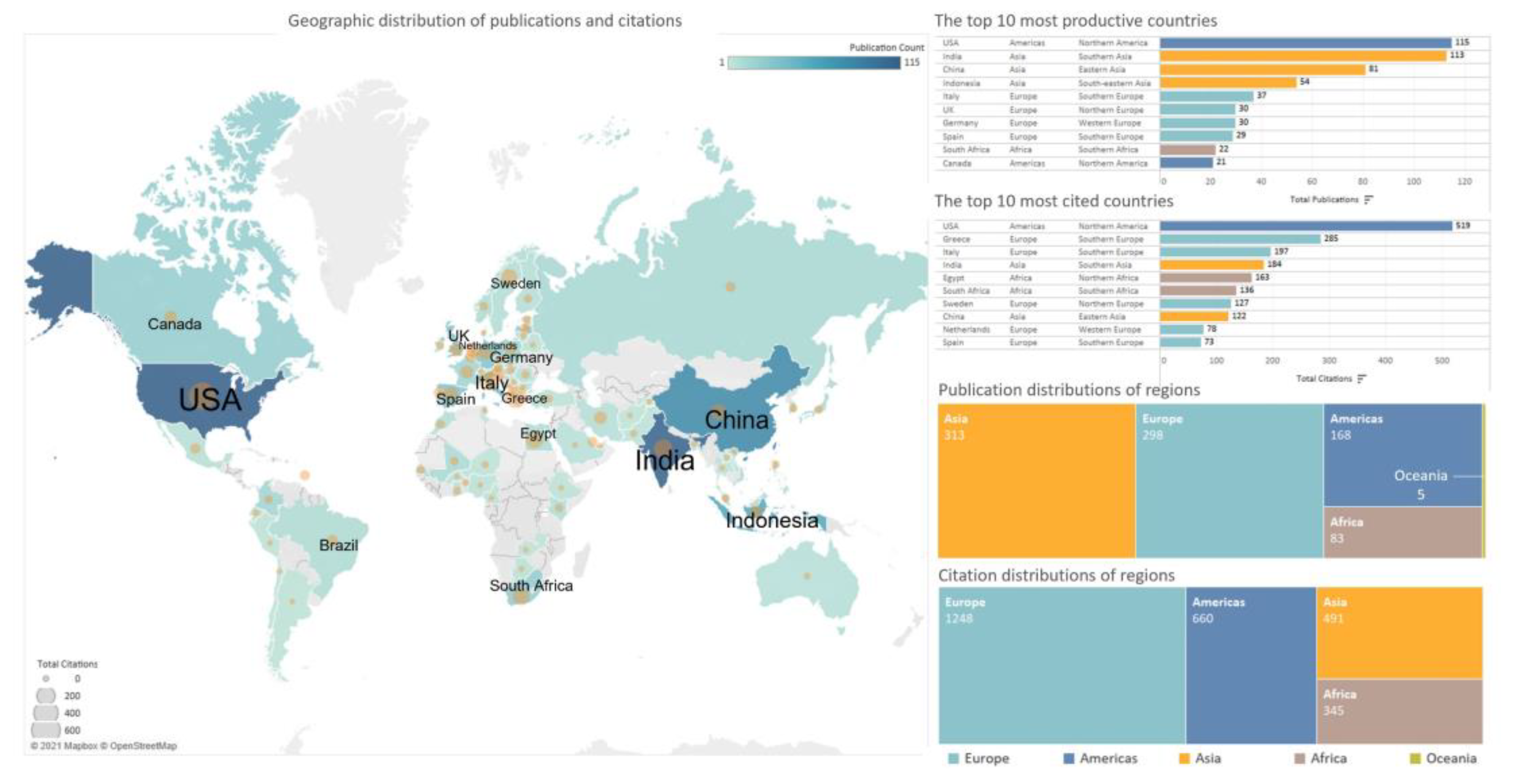
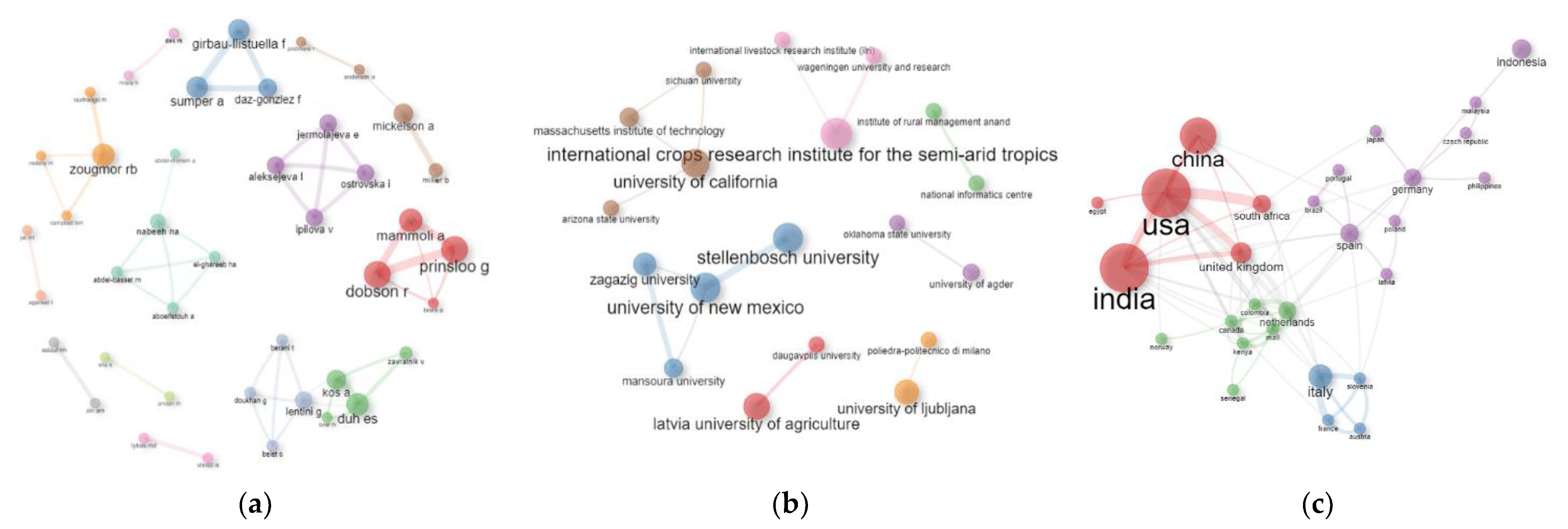

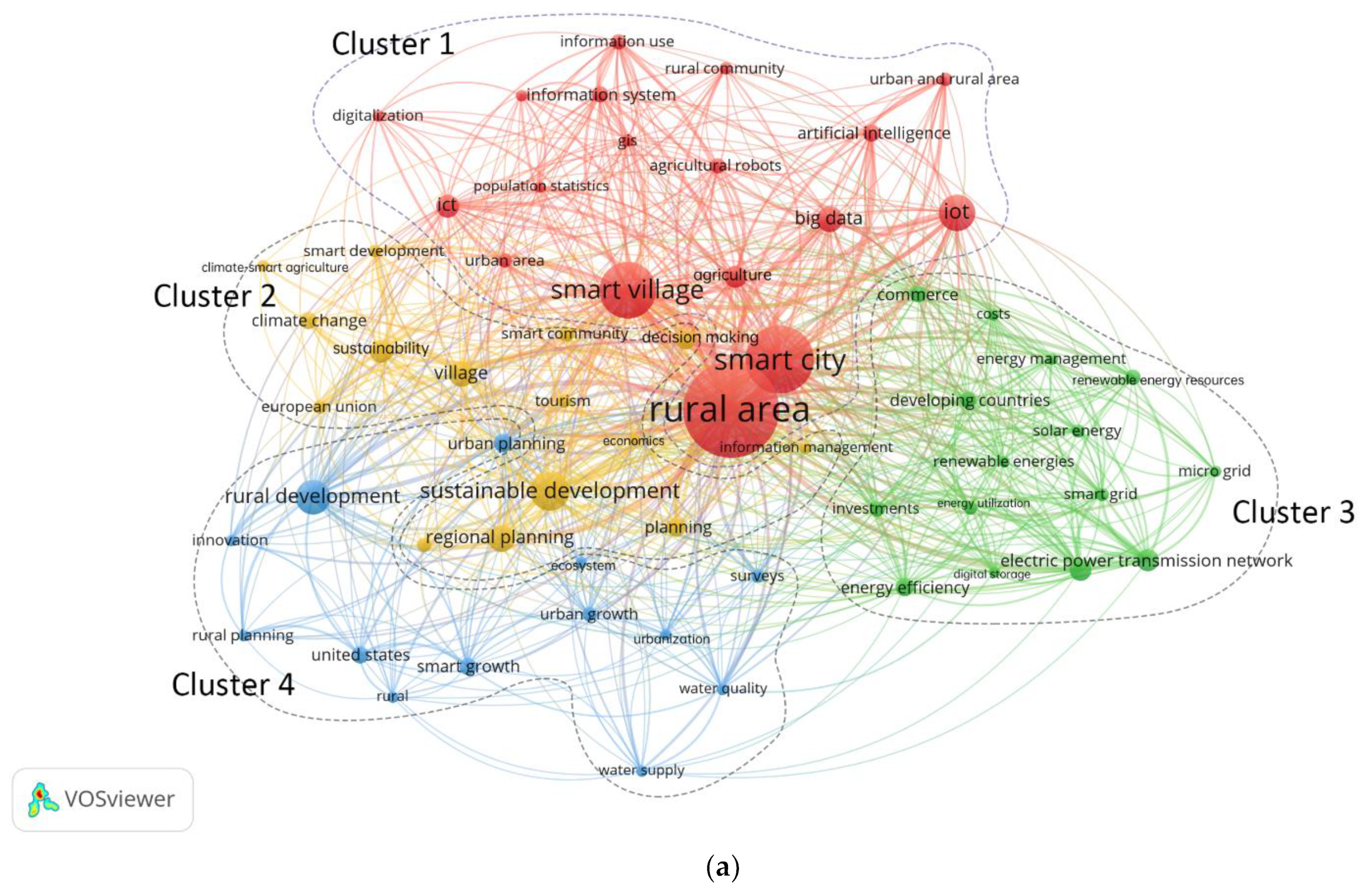
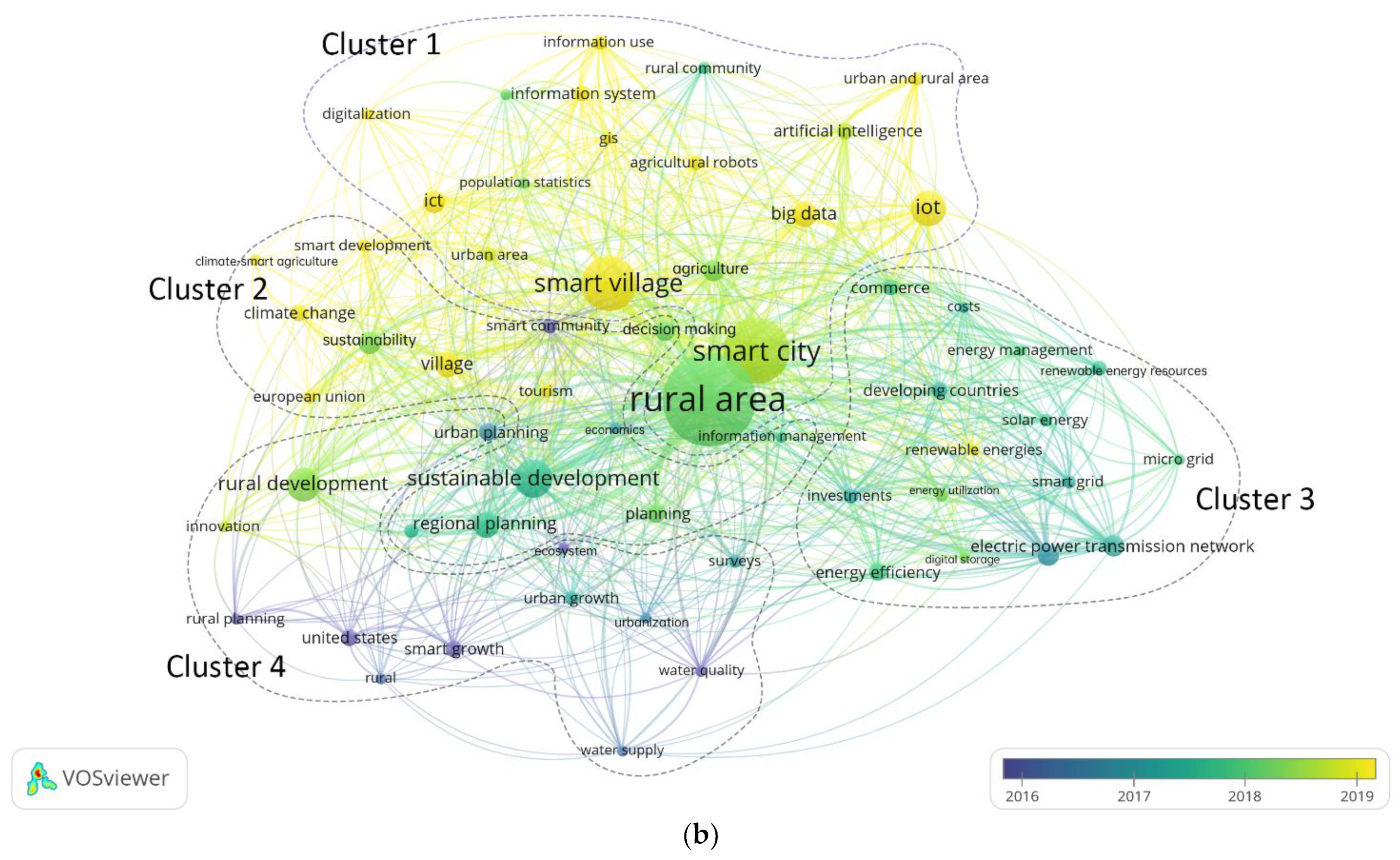
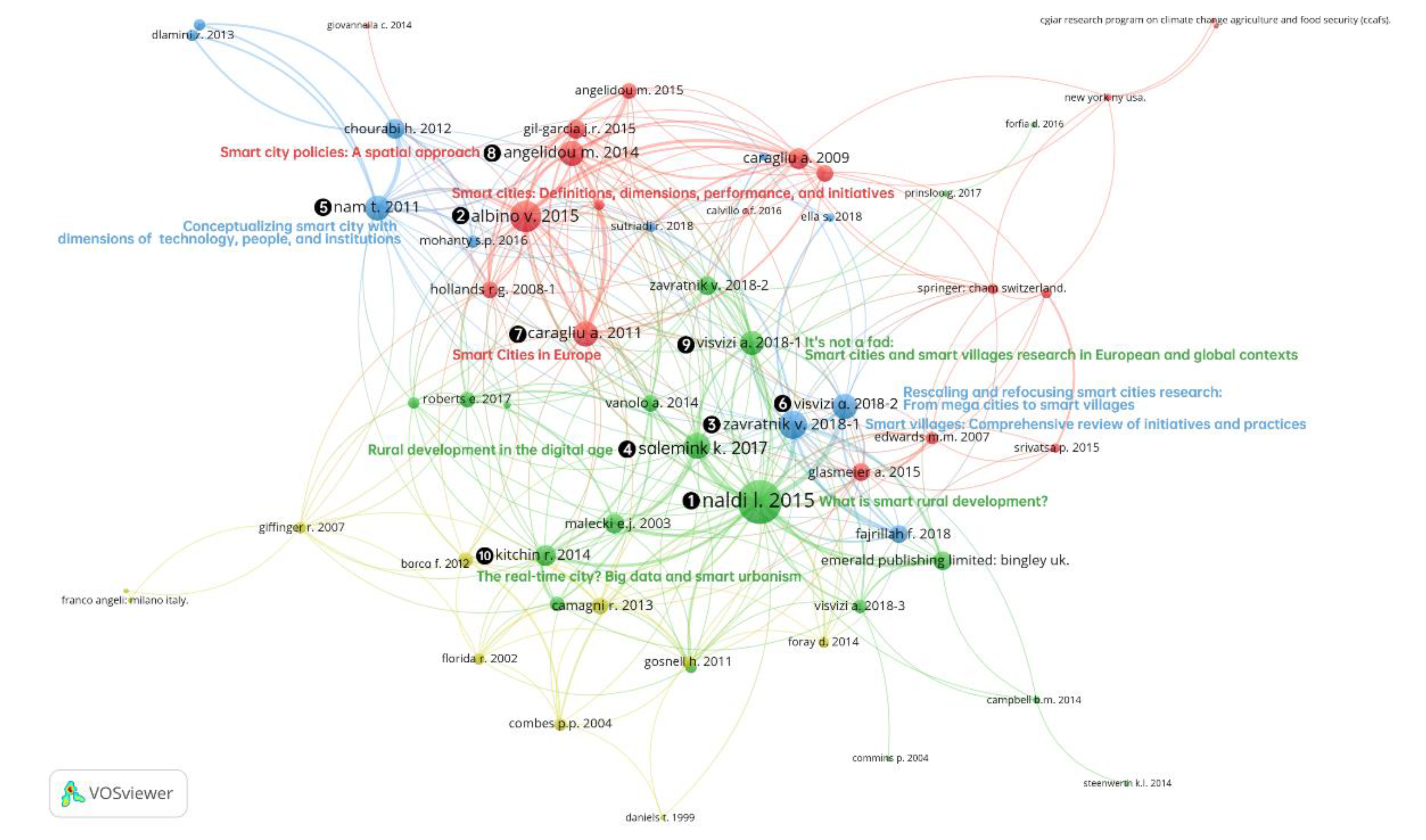
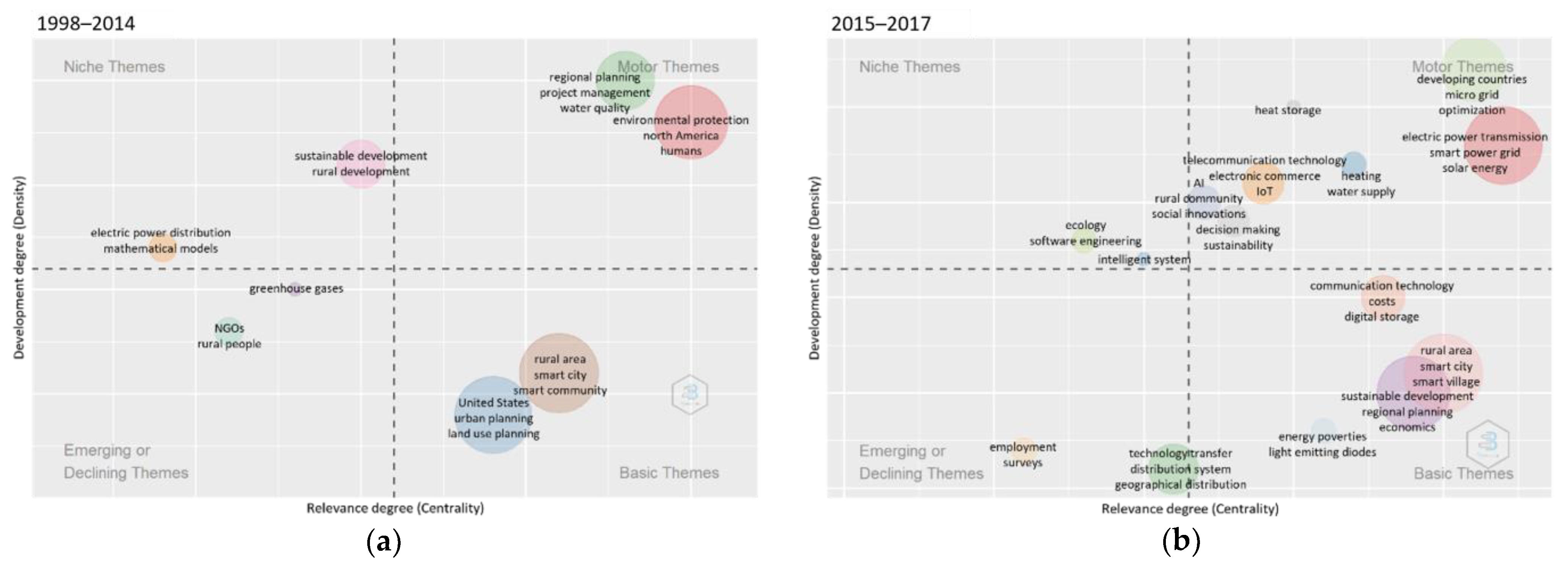
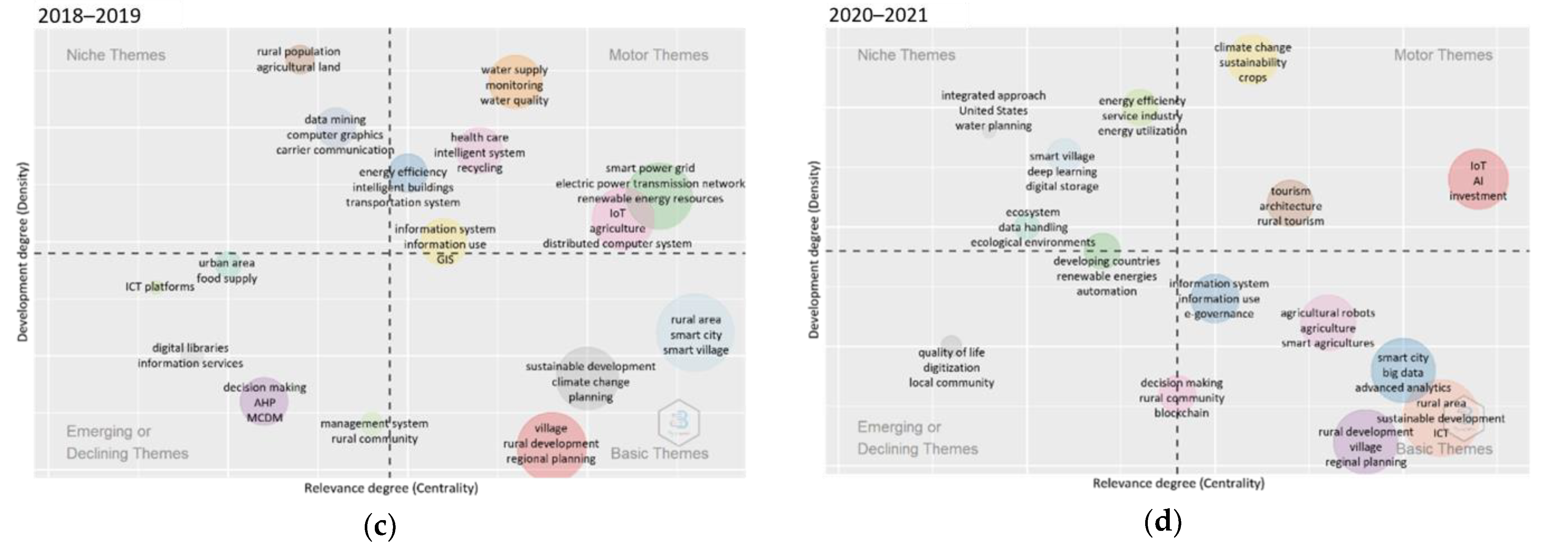
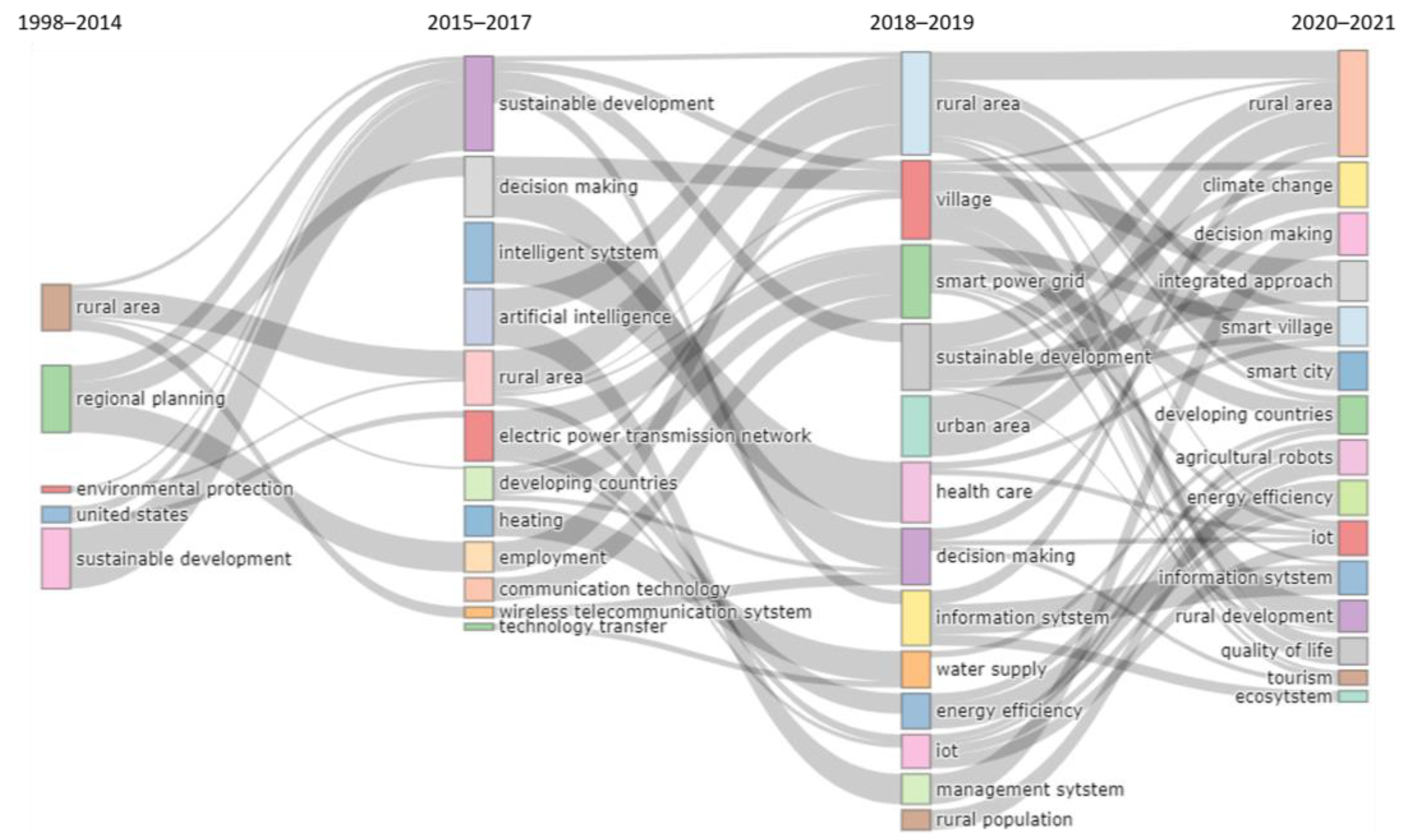
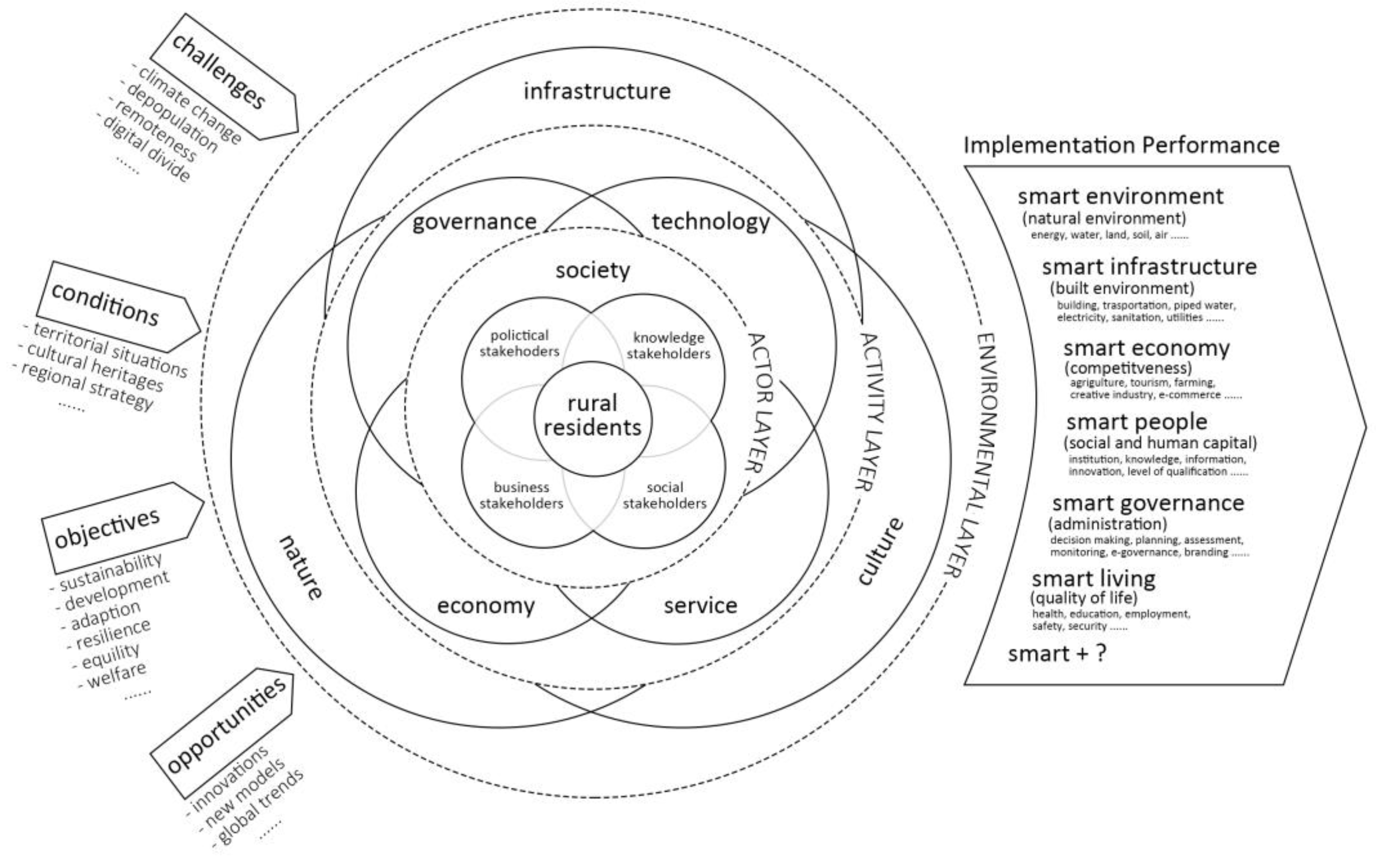
| 1. Worldwide Initiatives | ||||
|---|---|---|---|---|
| Year | Project or Program | Objectives | Affiliation | Source |
| 2011 | Climate-Smart Villages (CSVs) | To help farmers adapt to climate change | CGIAR Research Program on Climate Change, Agriculture, and Food Security (CCAFS) | [78] |
| 2014 | Smart Village Initiative (SVI) | To look at technical, entrepreneurial, and policy solutions to provide sustainable energy for off-grid rural community development | Smart Villages Research Group | [79] |
| 2014 | IEEE Smart Village (ISV) | To support the world’s energy-impoverished communities with renewable energy, community-based education, and entrepreneurial opportunities | IEEE Inc. | [80] |
| 2. Regional or National Agendas | ||||
| Year | Region or Nation | Representative Strategic Agendas | Vision | Source |
| 2010 | Malaysia | In 2010, the idea of Smart City Smart Village (SCSV) was presented and approved by Malaysia’s Global Science and Innovation Advisory Council (GSIAC). | To improve everything from energy use to healthcare, education, traffic, and shopping by doing it “smart” with the help of ICT and green technology. | [81] |
| 2016 | India | The Government of India has proposed the Shyama Prasad Mukherji Rurban Mission (SPMRM), or the so-called Smart Village program, aimed at developing such rural areas by the provision of economic, social, and physical infrastructure facilities. | To make villages smart and the growth centers of the nation. To develop a cluster of villages that preserve and nurture the essence of rural community life with a focus on equity and inclusiveness, without compromising the facilities perceived to be essentially urban in nature. | [82] |
| 2017 | European regions | In 2017, the European Commission launched the EU Action for Smart Villages, which aimed to prevent villages from declining due to remoteness and depopulation. | To initiate some reflections on the villages of the future based on a shared vision of balanced development in European regions and the need to provide rural areas and villages with opportunities for growth. | [83] |
| 2019 | China | The Chinese government issued the “Smart (Digital) Village Development Strategy Outline” in order to realize the sustainable development of rural areas through the construction of Smart Villages. | To revitalize rural areas in an all-round way, with a strong agricultural sector, a beautiful countryside, and full realization of farmers’ wealth by 2050. | [84,85] |
| Key Dimensions of a Smart Village | Source | Key Dimensions of a Smart Village | Source | |||
|---|---|---|---|---|---|---|
| 1. Smart Village Ecosystem | [76] | 5. Smart Village Digital Ecosystem | [88] | |||
| a | Institutions | a | Society | |||
| b | Resources | b | Digital service | |||
| c | Service delivery technologies and mechanisms | c | Technical platform | |||
| d | Service chains | d | Infrastructure | |||
| 2. Smart Village Conceptual Model | [36] | e | Organizational ecosystem | |||
| a | Energy | 6. Smart Village Model | [75] | |||
| b | Economy | a | Governance | |||
| c | ICT | b | Technology | |||
| d | People | c | Resources | |||
| e | Governance | d | Village services | |||
| f | Environment | e | Living | |||
| g | Living | f | Tourism | |||
| 3. Framework of a Smart Village | [74] | 7. Theoretical Framework for a Smart Village System | [85] | |||
| a | Resources | a | The strategic subsystem | |||
| b | Technology | b | The social subsystem | |||
| c | Service chains | c | The economic subsystem | |||
| d | Institutions | d | The information subsystem | |||
| e | Sustainability | e | The resource and environmental subsystem | |||
| 4. Smart Village model | [89] | 8. Dimensions of the Smart Village Concept | [4,90] | |||
| Process | Enabler | a | Management | |||
| a | Smart economy | Smart management | b | Quality of life | ||
| b | Smart technology | Smart industry | c | Economy | ||
| c | Smart society | Smart infrastructure | d | Society | ||
| d | Smart ecology | Smart people | e | Natural environment | ||
| e | Smart administration | Smart environment | f | Mobility | ||
| Dimensions | Elements | Dimensions | Elements | ||
|---|---|---|---|---|---|
| 1 | Society | Human capital, cultural capital, institutions, knowledge, information, innovation, etc. | 5 | Governance | Decision making, planning, monitoring, assessment, e-governance, branding, etc. |
| 2 | Resources | Energy, land, water, soil, air, etc. | 6 | Service | Sanitation, employment, health care, education, food supply, safety, housing, training, etc. |
| 3 | Infrastructure | Architecture, transportation, waste and water management, power grid, telecommunication, etc. | 7 | Technology | IoT, AI, cloud, blockchain, GIS, computing, smart grid, 5G, ICTs, etc. |
| 4 | Economy | Agriculture, farming, tourism, e-commerce, creative industry, etc. | 8 | Others | Strategies, objectives, challenges, conditions, etc. |
| No. | Author | Institution | Country (Region) | TP * | MAP | FAP | TC | TC/ TP |
|---|---|---|---|---|---|---|---|---|
| 1 | Robert Zougmore | CGIAR Research Program on CCAFS | Netherlands (Europe) | 7 | 7 | 1 | 86 | 12.29 |
| 2 | Robert T Dobson | Stellenbosch University | South Africa (Africa) | 6 | 6 | 0 | 111 | 18.5 |
| 3 | Gerro J Prinsloo | Stellenbosch University | South Africa (Africa) | 6 | 6 | 6 | 111 | 18.5 |
| 4 | Alan Mickelson | University of Colorado | USA (Americas) | 6 | 6 | 1 | 7 | 1.17 |
| 5 | Andrea Mammoli | University of New Mexico | USA (Americas) | 5 | 5 | 0 | 87 | 17.4 |
| 6 | Emilija Stojmenova Duh | University of Ljubljana | Slovenia (Europe) | 5 | 5 | 0 | 72 | 14.4 |
| 7 | Francesc Girbau-Llistuella | Polytechnic University of Catalonia | Spain (Europe) | 5 | 5 | 4 | 34 | 6.8 |
| 8 | Andreas Sumper | Polytechnic University of Catalonia | Spain (Europe) | 5 | 5 | 0 | 34 | 6.8 |
| 9 | Andrej Kos | University of Ljubljana | Slovenia (Europe) | 4 | 4 | 0 | 64 | 16 |
| 10 | Francisco Díaz-González | Polytechnic University of Catalonia | Spain (Europe) | 4 | 4 | 0 | 30 | 7.5 |
| 11 | Bennett Miller | University of Colorado | USA (Americas) | 4 | 4 | 1 | 1 | 0.25 |
| 12 | Miltiadis D. Lytras | Effat University | Saudi Arabia (Asia) | 3 | 3 | 1 | 345 | 115 |
| 13 | Anna Visvizi | Effat University | Saudi Arabia (Asia) | 3 | 3 | 1 | 345 | 115 |
| 14 | Nada A. Nabeeh | Mansoura University | Egypt (Africa) | 3 | 3 | 3 | 159 | 53 |
| 15 | Veronika Zavratnik | University of Ljubljana | Slovenia (Europe) | 3 | 3 | 3 | 61 | 20.33 |
| No. | Journal | TP * | TC | TC/TP | h-Index | CS | JCR Category |
|---|---|---|---|---|---|---|---|
| 1 | Sustainability | 21 | 365 | 17.38 | 8 | 3.9 | ● Social Sciences ● Environmental Science ● Energy |
| 2 | Energies | 9 | 113 | 12.56 | 5 | 4.7 | ● Mathematics ● Engineering ● Energy |
| 3 | European Countryside | 8 | 29 | 3.63 | 4 | 2.1 | ● Social Sciences ● Environmental Science |
| 4 | Journal of Rural Studies | 4 | 167 | 41.75 | 4 | 6.4 | ● Social Sciences |
| 5 | IEEE Access | 3 | 156 | 52.00 | 3 | 4.8 | ● Engineering ● Computer Science ● Materials Science |
| 6 | Journal of the American Planning Association | 3 | 87 | 29.00 | 3 | 6.6 | ● Social Sciences |
| 7 | Sensors | 3 | 19 | 6.33 | 3 | 5.8 | ● Physics and Astronomy ● Engineering ● Computer Science ● Physics and Astronomy ● Chemistry ● Biochemistry, Genetics, and Molecular Biology |
| 8 | IEEE Consumer Electronics Magazine | 3 | 13 | 4.33 | 2 | 6.4 | ● Engineering ● Computer Science |
| 9 | Water | 3 | 7 | 2.33 | 1 | 3.7 | ● Social Sciences ● Agricultural and Biological Sciences ● Environmental Science ● Biochemistry, Genetics, and Molecular Biology |
| 10 | Sustainable Cities and Society | 3 | 6 | 2.00 | 2 | 10.7 | ● Social Sciences ● Engineering ● Energy |
| No. | Title | Source | Author, Year |
|---|---|---|---|
| 1 | What is smart rural development? | Journal of Rural Studies | [27] |
| 2 | Smart cities: Definitions, dimensions, performance, and initiatives | Journal of Urban Technology | [91] |
| 3 | Smart villages: Comprehensive review of initiatives and practices | Sustainability | [7] |
| 4 | Rural development in the digital age: A systematic literature review on unequal ICT availability, adoption, and use in rural areas | Journal of Rural Studies | [104] |
| 5 | Conceptualizing smart cities with the dimensions of technology, people, and institutions | Proceedings of the 12th Annual International Digital Government Research Conference | [102] |
| 6 | Rescaling and refocusing smart cities research: From mega cities to smart villages | Journal of Science and Technology Policy Management | [25] |
| 7 | Smart Cities in Europe | Journal of Urban Technology | [101] |
| 8 | Smart city policies: A spatial approach | Cities | [103] |
| 9 | It’s not a fad: Smart cities and smart villages research in European and global contexts | Sustainability | [28] |
| 10 | The real-time city? Big data and smart urbanism | GeoJournal | [105] |
Publisher’s Note: MDPI stays neutral with regard to jurisdictional claims in published maps and institutional affiliations. |
© 2022 by the authors. Licensee MDPI, Basel, Switzerland. This article is an open access article distributed under the terms and conditions of the Creative Commons Attribution (CC BY) license (https://creativecommons.org/licenses/by/4.0/).
Share and Cite
Wang, Q.; Luo, S.; Zhang, J.; Furuya, K. Increased Attention to Smart Development in Rural Areas: A Scientometric Analysis of Smart Village Research. Land 2022, 11, 1362. https://doi.org/10.3390/land11081362
Wang Q, Luo S, Zhang J, Furuya K. Increased Attention to Smart Development in Rural Areas: A Scientometric Analysis of Smart Village Research. Land. 2022; 11(8):1362. https://doi.org/10.3390/land11081362
Chicago/Turabian StyleWang, Qian, Shixian Luo, Jiao Zhang, and Katsunori Furuya. 2022. "Increased Attention to Smart Development in Rural Areas: A Scientometric Analysis of Smart Village Research" Land 11, no. 8: 1362. https://doi.org/10.3390/land11081362
APA StyleWang, Q., Luo, S., Zhang, J., & Furuya, K. (2022). Increased Attention to Smart Development in Rural Areas: A Scientometric Analysis of Smart Village Research. Land, 11(8), 1362. https://doi.org/10.3390/land11081362








